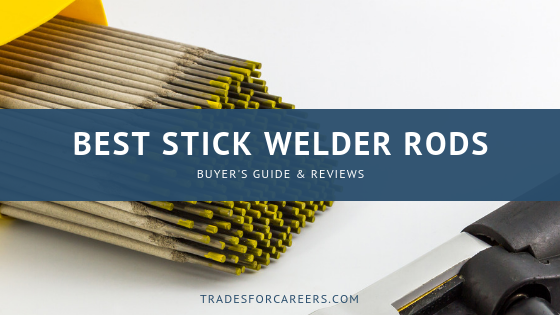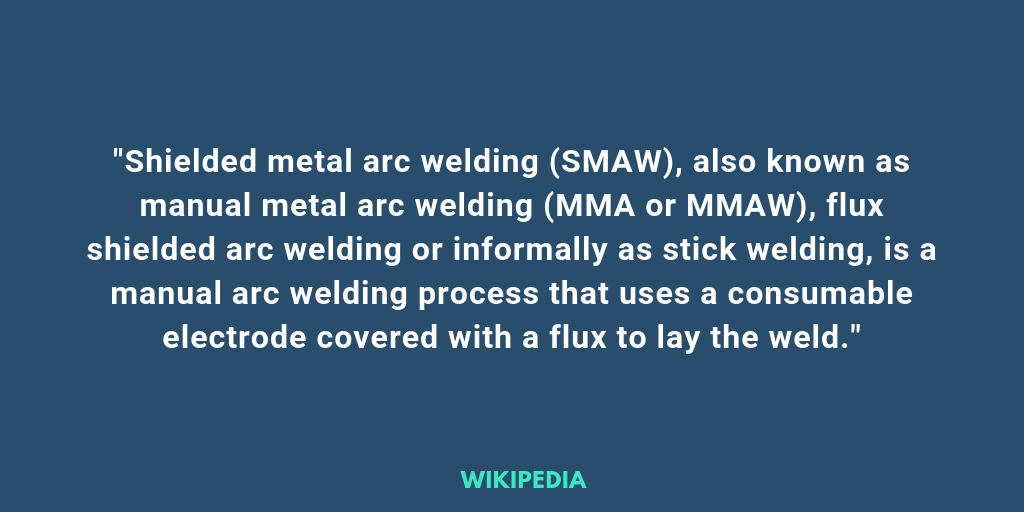Welcome to your ultimate guide to Stick welding for beginners! In the following post, you’ll find easy definitions, links to helpful Stick welding resources, equipment reviews, and tips for using the right stick welder settings and rods.
For the best Stick welding tips, check out the table of contents below.
Stick Welding for Beginners: Table of Contents
- What is Stick Welding?
- Stick Welding for Beginners: Advantages & Disadvantages
- Stick Welding Tips
- Beginner’s Guide to Stick Welding Sheet Metal
- Video: How to Weld with a Stick Welder
- Stick Welder Settings, Stick Welding Rods, & Where to Find a Welding Electrode Chart Online
- Stick Welding vs Mig Welding
- Best Stick Welding Equipment Reviews
Arc Welding Basics: What is Stick Welding?
Stick welding is a type of arc welding.
Of all the different kinds of welding, Stick welding is one of the most versatile. It’s also relatively inexpensive and useful for both industrial and household projects. Another term for this same welding method is Shielded Metal Arc Welding (SMAW), or Arc Welding for short.
Simply put, stick welding is a manual arc welding process that utilizes a flux-covered electrode to weld. Obviously, this is an overly simplified definition. But it’s a good starting point.
Here’s a great stick welding definition from Wikipedia:
It’s important to keep in mind that there are different names that refer to the exact same welding method. The following are synonymous with Stick welding:
- Shielded Metal Arc Welding (SMAW)
- Manual Metal Arc Welding (MMAW or even just MMA)
- Flux Shielded Arc Welding
Stick Welding for Beginners: Advantages & Disadvantages
Like all the different types of welding methods, Stick welding has its pros and cons, especially when you’re a beginner.
On the positive side, there are many benefits to Stick welding:
- Versatility: For example, this type of welding method can be applied to anything from shipbuilding to oil refineries to home welding projects. Also, Stick welding is compatible with many alloys and metals.
- Portability: Stick welding in particular makes outdoor projects are very doable. And there’s less material to carry around.
- Cost: In general, Stick welding equipment is inexpensive.
On the other hand, here are some disadvantages to Stick welding:
- Manual process: Specifically, stick welding is a manual process. Without the ease of an automatic process, it requires more time and the relative cost of deposited weld metal is pretty high. Another drawback to being manual is that it’s more difficult and doesn’t deliver as clean of welds.
- Somewhat Limited: Unfortunately, Stick welding is only compatible with metals thicker than 18 gauge.
- Incompatibilities: Stick welding is incompatible with metals that are reactive, such as columbiam, zirconium, tantalum, and titanium. This is because the shielding doesn’t prevent oxygen contamination.
Basic Stick Welding Tips
Overall, stick welding can be difficult to learn. However, you shouldn’t let this stop you! After time spent researching and practicing, you’ll be doing just fine. Once you become a certified welder, you’ll get arc welding down in no time.
To summarize, you should have a good handle on CLAMS:
-
-
- Current Stick Welder Settings
- Length of Arc
- Amperage
- Manipulate the stick welding electrodes with care
- Speed
-
Here are some wonderful web pages with information about Stick welding for beginners:
- Welding Tips, Tricks, & Information: Stick Welding
- Welding Consumables
- Different Types of Welding Rods
- Shielded Metal Arc Welding
Safety
For more in-depth Safety Stick Welding Tips, we recommend checking out these 3 videos/articles:
- Advanced Stick Welding Safety
- 12 Tips for Improving Welding Safety
- Video: Stick Welding Safety Techniques
Video: Stick Welding Tips for Beginners
For a quick guide to making good stick welds, take a peak at this video by 3 Welders.
Stick Welding Sheet Metal: Essential Tricks
If you’re looking for help with stick welding sheet metal, here are some great resources:
- How to Weld Sheet Metal with a Stick Welder
- Video: How to Weld Sheet Metal with a Stick Welder
- Basic Tips to Improve Stick Welding
Video: How to Weld with a Stick Welder
Stick Welder Settings: Using a Welding Electrode Chart
A welding electrode is a type of welding rod. In other words, it’s a wire connecting the welding machine with the metals you’re fusing together.
In SMAW/Stick welding, this rod is an electrode, or consumable electrode, since it melts together with the pieces you’re welding. The term “consumable” makes sense, since you’re never going to be using that particular welding electrode again. It becomes one with the weld.

The 3 Types of Stick Welder Rods
Altogether, there are 3 different types of stick welder rods:
- Light Coated Electrodes
- Heavy Coated Electrodes
- Shielded Arc Electrodes
How to Choose the Right Types of Welding Electrodes
First, it’s important to choose the right stick electrode.
Understandably, it’s tough to know what type of welding electrode to use. After all, there are so many options – and using a welding electrode chart? It can take some practice.
The following are more great resources for how to use a welding electrode chart:
Using a Welding Electrode Chart with Stick Welder Settings
Simply put, an electrode amperage chart helps you decide which type of welding rod to use depending on factors such as the thickness of the metal.
Here are some free welding electrode charts:
The best stick welder should come with specific stick welding electrode charts.
For a complete guide, check out The Internet’s Greatest Hacks for Understanding Stick Welder Rods.
Stick Welding vs Mig Welding
Stick and MIG welding have some things in common:
- Both types of welding processes require that you use safety precautions and gadgets to protect yourself from injury.
- Also, both require that you prepare a clean joint that has no rust, paint or water.
- They both require correct amperage and polarity set-up.
- Finally, can be done by beginners and professional quite effectively.
On the other hand, here are some notable differences in Mig Welding vs Stick Welding:
- First and foremost, stick welding is a bit tougher than MIG. That’s why it’s best to tackle Mig first. (But not a requirement.)
- Second, Stick welding takes longer. In other words, it just requires more time to complete a project.
- Along with being more difficult in general, Stick welding doesn’t deliver as clean of welds as MIG.
- In Stick’s favor, stick welding is best for outdoor welding projects. Unlike MIG, this type of welding process doesn’t rely on gas.
Reviews of the Essential Stick Welding Equipment Online
Luckily, there’s plenty of affordable stick welding accessories online. The following are links to reviews of Gas Metal Arc welding supplies:
- Different Types of Welding Machines: A Stick Welder is Right for You if…
- Best Stick Welder Reviews
- Best Stick Welding Rods
- Best Stick Welding Gloves
- Stick Welding Electrodes
- Auto Arc Welding Helmet
- Stick Welding Electrode Holder

Stick Welding Tips: Final Thoughts
As we wrap up this guide to Stick Welding for Beginners, we hope you’ve found the info you need to enjoy the satisfaction of good stick welds. If you struggle in the beginning, don’t worry.
Bookmark this page so you have a list of the best Stick welding tips articles and videos and come back to it whenever you need a refresher.
Of course, you can expect a freshly updated page with all of the latest resources. Happy welding!
And don’t forget to check out other posts that will help you with Stick welding:
Best Stick Welder Reviews: Detailed Buyer’s Guide
How to Find the Best Cheap Stick Welder Under $200 (Reviews)
8 Welding Helmets Guaranteed to Make Your Wallet Happier

